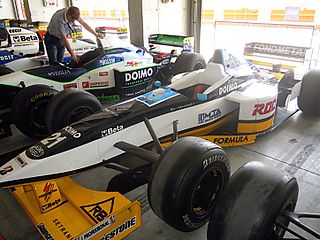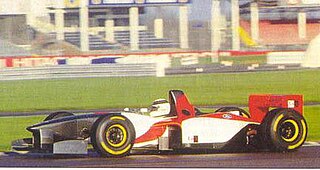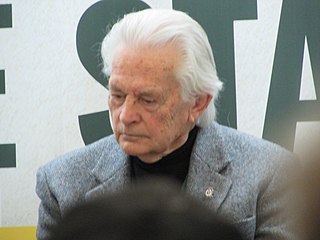
The Formula 3000 International Championship was a motor racing series created by the Fédération Internationale de l'Automobile (FIA) in 1985 to become the final preparatory step for drivers hoping to enter Formula One. Formula Two had become too expensive, and was dominated by works-run cars with factory engines; the hope was that Formula 3000 would offer quicker, cheaper, more open racing. The series began as an open specification, then tyres were standardized from 1986 onwards, followed by engines and chassis in 1996. The series ran annually until 2004, and was replaced in 2005 by the GP2 Series.
Lola Cars International Ltd. was a British race car engineering company in operation from 1958 to 2012. The company was founded by Eric Broadley in Bromley, England, before moving to new premises in Slough, Buckinghamshire and finally Huntingdon, Cambridgeshire, and endured for more than fifty years to become one of the oldest and largest manufacturers of racing cars in the world. Lola Cars started by building small front-engined sports cars, and branched out into Formula Junior cars before diversifying into a wider range of sporting vehicles.

The 1997 Australian Grand Prix was a Formula One motor race held at the Albert Park Circuit in Melbourne on 9 March 1997. It was the first race of the 1997 Formula One World Championship, and the second Australian Grand Prix to be held in Melbourne.

The 1997 Brazilian Grand Prix was a Formula One motor race held at Autódromo José Carlos Pace near Interlagos, Brazil on 30 March 1997. It was the second race of the 1997 Formula One season. The 72-lap race was won by Williams driver Jacques Villeneuve after he started from pole position. Gerhard Berger finished second for the Benetton team and Prost driver Olivier Panis was third.

The 1997 FIA Formula One World Championship was the 51st season of FIA Formula One motor racing. It featured the 1997 Formula One World Championship for Drivers and the 1997 Formula One World Championship for Constructors, which were contested concurrently over a seventeen-race series that commenced on 9 March and ended on 26 October.
Ricardo Rosset is a Brazilian racing driver. Runner-up in the 1995 International Formula 3000 Championship, he later participated in 33 Formula One Grands Prix, making his debut at the 1996 Australian Grand Prix. He scored no championship points. He eventually quit Formula One to focus on developing a sportswear business in Brazil.
Vincenzo Sospiri is an Italian former racing driver.

The MasterCard Lola Formula One Racing Team, often known as MasterCard Lola or simply Lola, was a shortlived British Formula One team that contested only one race in the 1997 Formula One World Championship. It quickly withdrew from the sport after failing to qualify on its debut at the 1997 Australian Grand Prix, where the cars were more than 11 seconds off the pace in qualifying.
Eric Harrison Broadley MBE was a British entrepreneur, engineer, and founder and chief designer of Lola Cars, the motor racing manufacturer and engineering company. He was arguably one of the most influential automobile designers of the post-war period, and over the years Lola was involved with many high-profile projects in Formula One, IndyCar, and sports car racing. Broadley sold Lola to Martin Birrane in 1997.

The Minardi M197 was the car with which the Minardi Formula One team competed in the 1997 Formula One season.

The Pacific PR01 is a Formula One car, designed by Paul Brown for the 1993 season. However, due to financial problems, it did not race until 1994.
The 107% rule is a sporting regulation affecting Formula One racing qualifying sessions. During the first phase of qualifying, if the circuit is dry, any driver who is eliminated in the first qualifying session and fails to set a lap within 107% of the fastest time in that session will not be allowed to start the race without permission from the race stewards. For example, if the fastest Q1 lap time was 100 seconds, each driver who is eliminated in the session must complete at least one lap within 107 seconds to guarantee a race start. The 107% rule was introduced for the 1996 season and remained in force until 2002. It was reintroduced for the 2011 season with minor modifications due to the knock-out qualifying format.

The Lola T93/30 was the Formula One car built by Lola Cars and raced by the BMS Scuderia Italia team for the 1993 Formula One season. Scuderia Italia, which did not construct its own cars, had previously run Dallara chassis since its first season in 1988, but team owner Beppe Lucchini elected to switch to Lola after an uncompetitive 1992 season.

The Lola T95/30 is a Formula One motor racing car which was tested by Allan McNish during 1994 and early 1995. The car, however, was not raced during any Formula One races. The car was designed as a prototype ready for Lola's arrival in Formula One. Lola, instead of actually racing the car in the season, chose instead to test the car while searching for a big-name sponsor as money for the project dried up. The T95/30 version could not be raced as it was made obsolete by regulation changes enforced by the Fédération Internationale de l'Automobile (FIA), Formula One's governing body.

The DAMS GD-01 was an unraced Formula One car used by the French motorsport team, Driot-Arnoux Motor Sport (DAMS). The GD-01 was designed and built by a collaboration of DAMS and Reynard engineers from 1994 to 1995, and was intended to establish the team—which had achieved considerable success in lower categories—in Formula One (F1), the premier Fédération Internationale de l'Automobile (FIA)-sanctioned level of racing. However, due to insufficient financial backing, the team never entered the championship, despite completing construction of the chassis and conducting limited testing.
Claude Galopin is a French automotive engineer.

The Dome F105 was an unraced Formula One car designed and built by the Japanese motorsport constructor, Dome.

Reynard Motorsport was the world's largest racing car manufacturer in the 1980s. Initially based at Bicester and latterly at Reynard Park, Brackley, England the company built successful cars in Formula Ford 1600, Formula Ford 2000, Formula Vauxhall Lotus, Formula Three, Formula 3000 and CART.

Tony Southgate is an English engineer and former racing car designer. He designed many successful cars, including Jaguar's Le Mans-winning XJR-9, and cars for almost every type of circuit racing. He was responsible for the chassis design of Ford's RS200 Group B rally car. Southgate was employed as chief designer or technical director for many Formula One teams for over twenty years. These teams included BRM, Shadow and Arrows. Southgate retired after producing the Audi R8C, which was a major influence in the Bentley Speed 8, which won Le Mans in 2003. He continues to be a regular visitor to current and historic race meetings.
The EC and ED family are a series of 3.0-litre and 3.5-litre, naturally-aspirated, V8, Formula One racing engines, designed, developed and produced by Cosworth, in partnership with Ford; and used between 1994 and 1997. The customer engines were used by Benetton, Sauber, Forti, Lola, Simtek, Pacific, Minardi, and Tyrrell.













